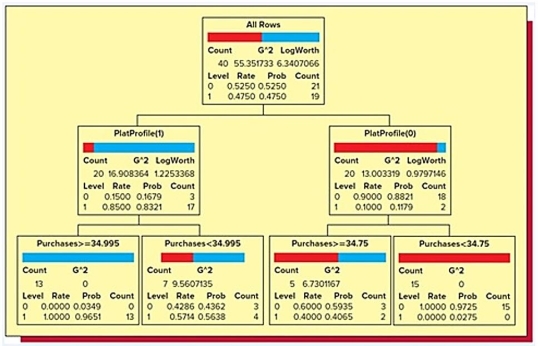Suppose that a bank wishes to predict whether or not an existing holder of its Silver credit card will upgrade, for an annual fee, to its Platinum credit card. To do this, the bank carries out a pilot study that randomly selects 40 of its existing Silver card holders and offers each Silver card holder an upgrade to its Platinum card. Here, the response variable Upgrade equals 1 if the Silver card holder decided to upgrade and 0 otherwise. Moreover, the predictor variable Purchases is last year's purchases (in thousands of dollars) by the Silver card holder, and the predictor variable PlatProfile equals 1 if the Silver card holder conforms to the bank's Platinum profile and 0 otherwise. Below is the classification tree they derived from the data collected in the study.  Assume they classify those with an upgrade probability estimate of at least .5 as upgraders. Based on this classification tree, a member of the study sample who made $28,520 in purchases last year and conformed to the bank's Platinum profile but did not upgrade to the Platinum card would be…
Assume they classify those with an upgrade probability estimate of at least .5 as upgraders. Based on this classification tree, a member of the study sample who made $28,520 in purchases last year and conformed to the bank's Platinum profile but did not upgrade to the Platinum card would be…
A) accurately classified as an upgrader.
B) accurately classified as a non-upgrader.
C) inaccurately classified as an upgrader.
D) inaccurately classified as a non-upgrader.
Correct Answer:
Verified
Q25: An internet service provider (ISP) has randomly
Q26: Which of the following possible response variables
Q27: An internet service provider (ISP) has randomly
Q28: The k-nearest neighbors approach can be used
Q29: The naive Bayes' classification procedure can be
Q31: Dividing the entire data set into a
Q32: An internet service provider (ISP) has randomly
Q33: Combining the estimates or predictions obtained from
Q34: Suppose that a bank wishes to predict
Q35: Which of the following possible response variables
Unlock this Answer For Free Now!
View this answer and more for free by performing one of the following actions

Scan the QR code to install the App and get 2 free unlocks

Unlock quizzes for free by uploading documents